入门教程:.NET开源OpenID Connect 和OAuth解决方案IdentityServer v3 MVC认证与授权(四)
本教程将搭建一个最小能够运行的IdentityServer。为简单起见,我们将identityserver和客户端放在同一Web应用程序-这可能不会是一个很现实的情况下,但可以让你不太复杂的开始。
完整的源代码可以在这里找到。
Part 1 - MVC MVC认证与授权
在第一部分中我们将创建一个简单的MVC应用程序并添加认证通过identityserver它。然后,我们将有一个更仔细的看claims,claims的变化和授权.
创建一个 web application
在Visual Studio 2013中,创建一个标准的MVC应用程序和设置认证,“没有认证”。
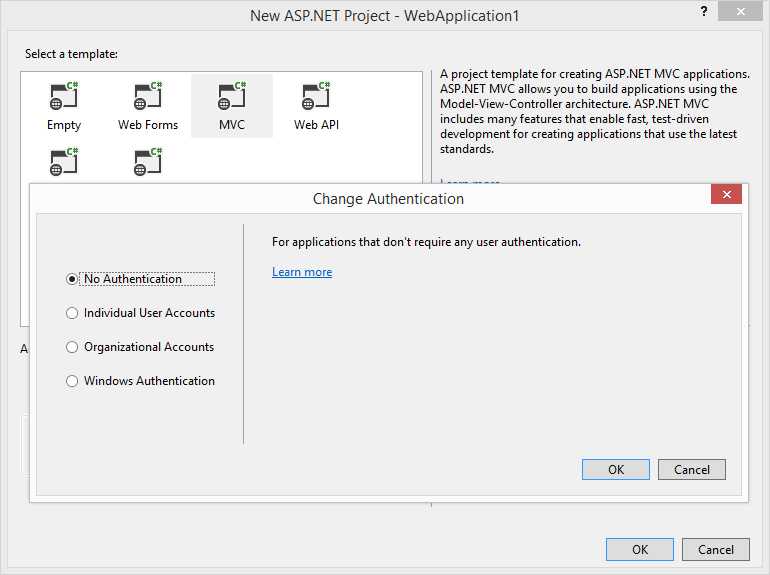
你可以在属性窗口启用SSL
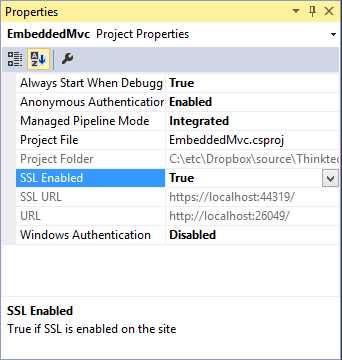
注意:不要忘记更新你的项目属性中的url
添加 IdentityServer 引用
IdentityServer基于OWIN/Katana作为NuGet包。要将其添加到新创建的应用程序上,安装以下2个包:
install-package Microsoft.Owin.Host.Systemweb
install-package Thinktecture.IdentityServer3
IdentityServer配置——客户端
IdentityServer需要一些关于客户端信息,这可以简单地提供使用客户端对象:
public static class Clients { public static IEnumerable<Client> Get() { return new[] { new Client { Enabled = true, ClientName = "MVC Client", ClientId = "mvc", Flow = Flows.Implicit, RedirectUris = new List<string> { "https://localhost:44319/" } } }; } }
IdentityServer配置——用户
下一步我们将添加一些IdentityServer用户-这里通过提供一个简单的C#类完成,当然你可以从任何数据存储加载用户。我们提供了ASP.NET Identity 和MembershipReboot支持检索用户信息。
public static class Users { public static List<InMemoryUser> Get() { return new List<InMemoryUser> { new InMemoryUser { Username = "bob", Password = "secret", Subject = "1", Claims = new[] { new Claim(Constants.ClaimTypes.GivenName, "Bob"), new Claim(Constants.ClaimTypes.FamilyName, "Smith") } } }; } }
添加 Startup.cs
配置启动类。在这里,我们提供有关客户信息的用户,范围,签名证书和其他一些配置选项。生产要从Windows证书存储区或其他固定源负载签名证书。这里我们简单地添加到项目文件(你可以下载一个测试证书的地方。它添加该项目并将其属性【复制到输出目录】更改为始终复制。
public class Startup { public void Configuration(IAppBuilder app) { app.Map("/identity", idsrvApp => { idsrvApp.UseIdentityServer(new IdentityServerOptions { SiteName = "Embedded IdentityServer", SigningCertificate = LoadCertificate(), Factory = InMemoryFactory.Create( users : Users.Get(), clients: Clients.Get(), scopes : StandardScopes.All) }); }); } X509Certificate2 LoadCertificate() { return new X509Certificate2( string.Format(@"{0}\bin\identityServer\idsrv3test.pfx", AppDomain.CurrentDomain.BaseDirectory), "idsrv3test"); } }
在浏览器中输入以下地址以检查配置https://localhost:44319/identity/.well-known/openid-configuration
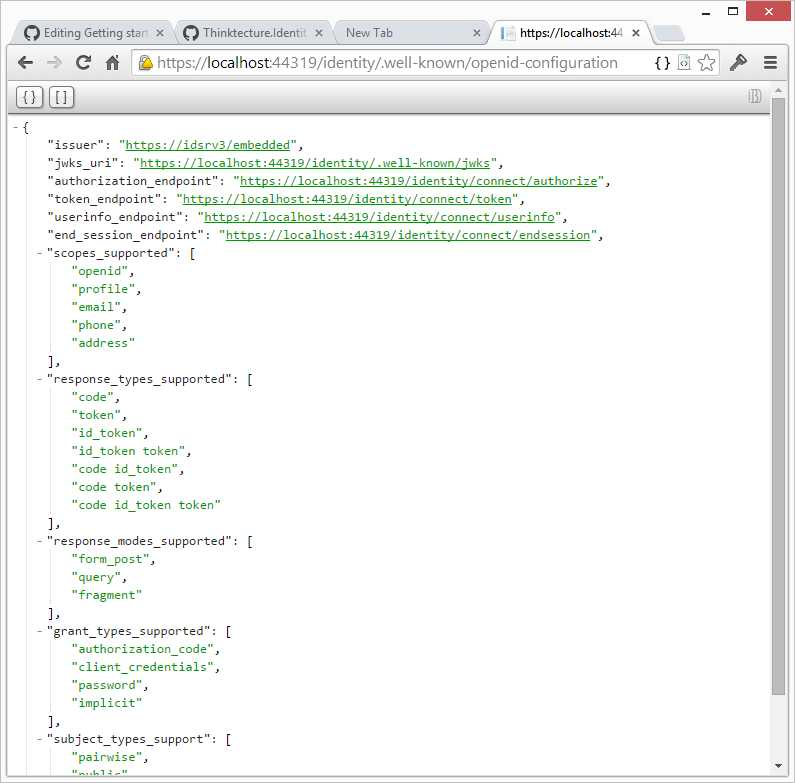
注意:
最后一件事,在配置文件中添加下面的代码,否则我们的一些嵌入式资产将不能正确使用IIS加载
<system.webServer> <modules runAllManagedModulesForAllRequests="true" /> </system.webServer>
添加和配置OpenID Connect 中间件
增加OIDC 认证的MVC应用程序中,我们需要添加两包:
install-package Microsoft.Owin.Security.Cookies
install-package Microsoft.Owin.Security.OpenIdConnect
在startup.cs中配置默认认证类型为cookie
app.UseCookieAuthentication(new CookieAuthenticationOptions { AuthenticationType = "Cookies" });
使用嵌入的OpenID Connect Server
app.UseOpenIdConnectAuthentication(new OpenIdConnectAuthenticationOptions { Authority = "https://localhost:44319/identity", ClientId = "mvc", RedirectUri = "https://localhost:44319/", ResponseType = "id_token", SignInAsAuthenticationType = "Cookies" });
添加一个受保护的资源和Claims
一个受保护的资源:
[Authorize] public ActionResult About() { return View((User as ClaimsPrincipal).Claims); }
相应的视图看起来像这样:
@model IEnumerable<System.Security.Claims.Claim> <dl> @foreach (var claim in Model) { <dt>@claim.Type</dt> <dd>@claim.Value</dd> } </dl>
Authentication and claims
点击About链接将触发认证。identityserver将显示登录页面
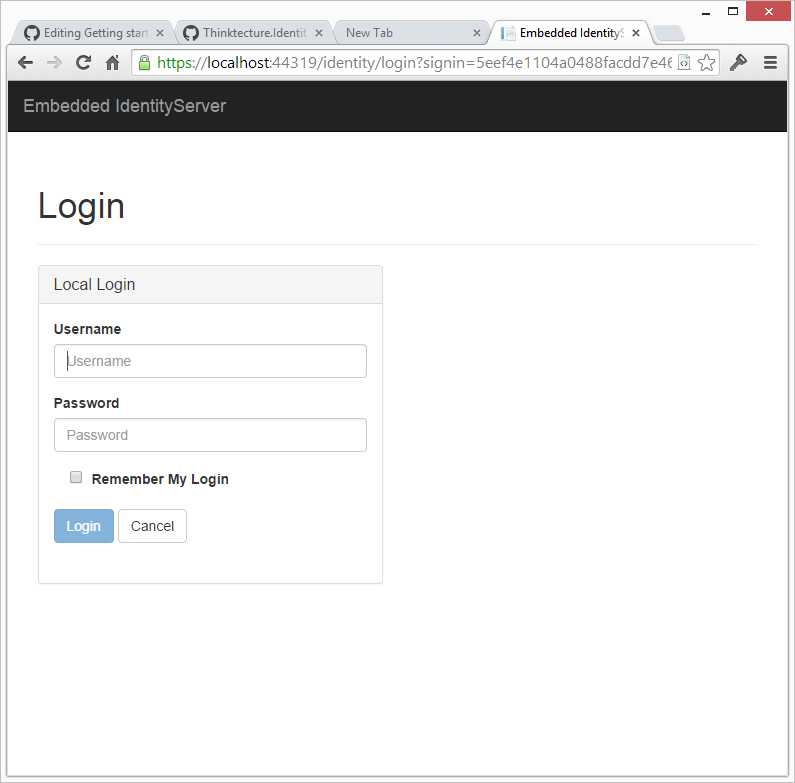
登录成功后可以看到登录信息:
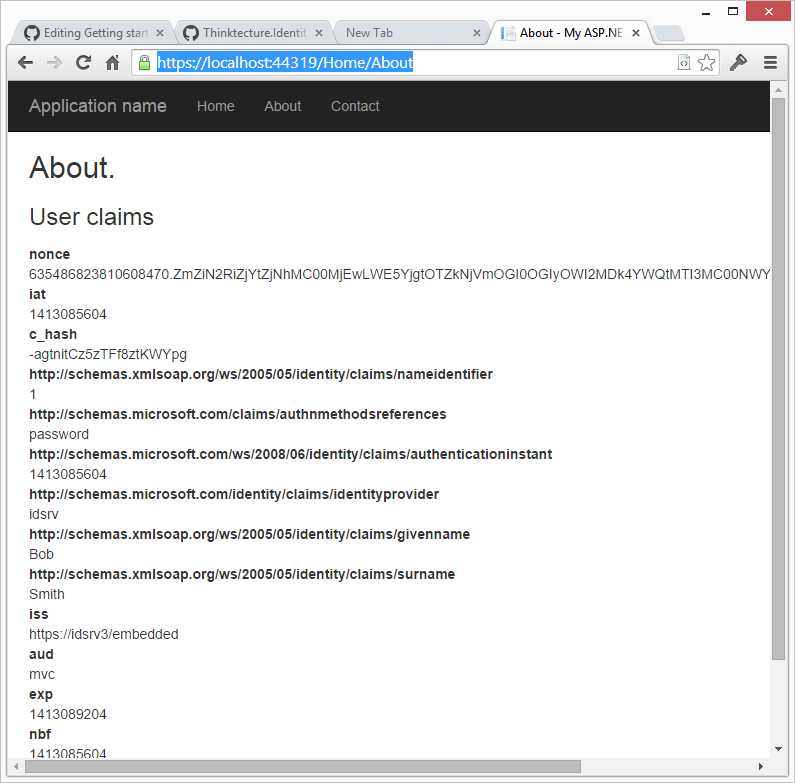
增加Role Claim 和 Scope
在下一步中,我们要向我们的用户添加一些角色声明,我们将在以后使用它来进行授权。
现在我们有了OIDC 标准scope-定义一个角色的scope包括claims,和一些标准属性:
public static class Scopes { public static IEnumerable<Scope> Get() { var scopes = new List<Scope> { new Scope { Enabled = true, Name = "roles", Type = ScopeType.Identity, Claims = new List<ScopeClaim> { new ScopeClaim("role") } } }; scopes.AddRange(StandardScopes.All); return scopes; } }
改变在Startup.cs的factory类使用定义的scope
Factory = new IdentityServerServiceFactory() .UseInMemoryUsers(Users.Get()) .UseInMemoryClients(Clients.Get()) .UseInMemoryScopes(Scopes.Get()),
下一步我们为bob添加几个Claim
public static class Users { public static IEnumerable<InMemoryUser> Get() { return new[] { new InMemoryUser { Username = "bob", Password = "secret", Subject = "1", Claims = new[] { new Claim(Constants.ClaimTypes.GivenName, "Bob"), new Claim(Constants.ClaimTypes.FamilyName, "Smith"), new Claim(Constants.ClaimTypes.Role, "Geek"), new Claim(Constants.ClaimTypes.Role, "Foo") } } }; } }
改变中间件配置:
app.UseOpenIdConnectAuthentication(new OpenIdConnectAuthenticationOptions { Authority = "https://localhost:44319/identity", ClientId = "mvc", Scope = "openid profile roles", RedirectUri = "https://localhost:44319/", ResponseType = "id_token", SignInAsAuthenticationType = "Cookies" });
成功验证后,您现在应该看到用户Claim集合中的角色Claim
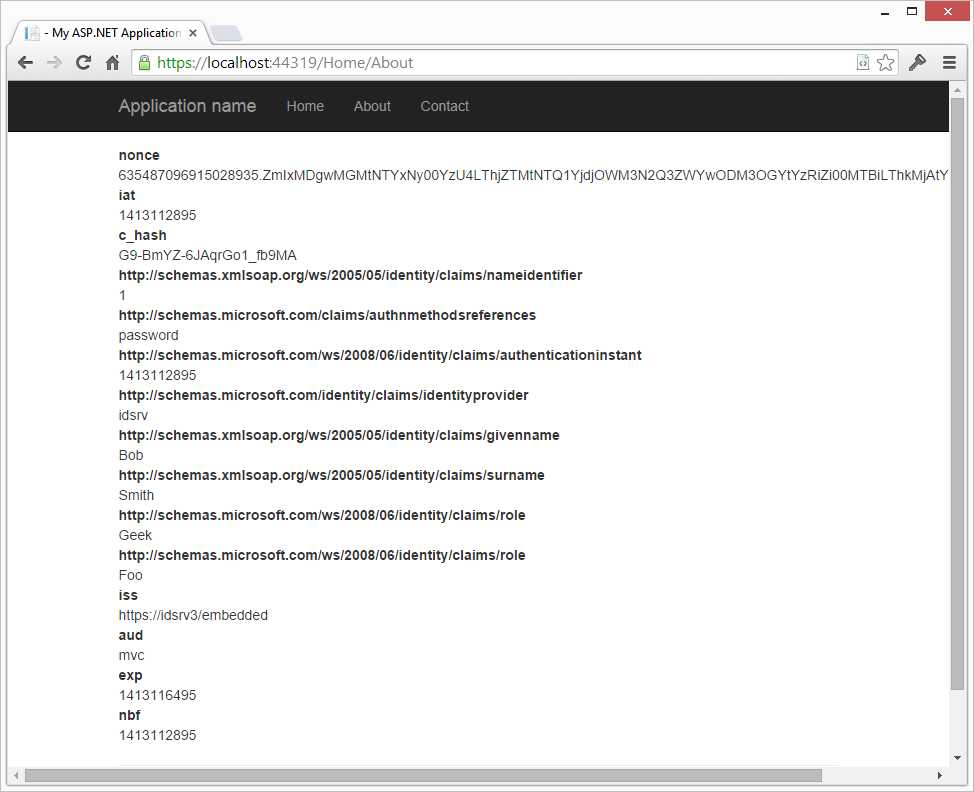
Claims 转换
默认情况下那些Claims看起像这样:
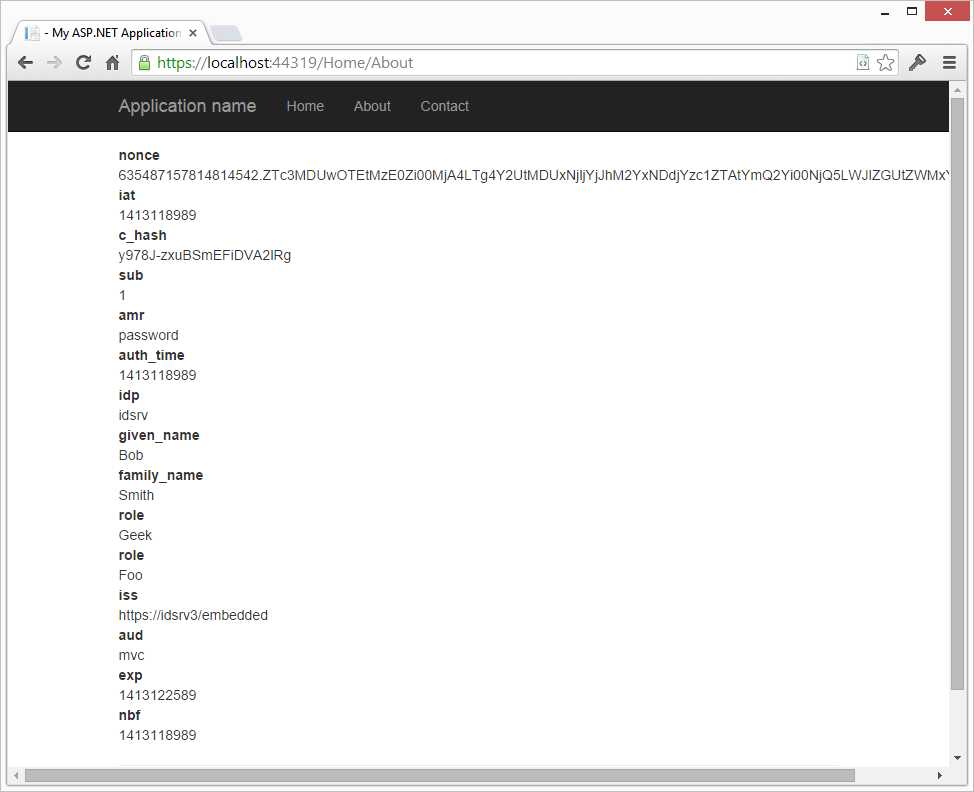
通过配置可以控制哪些claim需要被记录:
app.UseOpenIdConnectAuthentication(new OpenIdConnectAuthenticationOptions { Authority = "https://localhost:44319/identity", ClientId = "mvc", Scope = "openid profile roles", RedirectUri = "https://localhost:44319/", ResponseType = "id_token", SignInAsAuthenticationType = "Cookies", UseTokenLifetime = false, Notifications = new OpenIdConnectAuthenticationNotifications { SecurityTokenValidated = async n => { var id = n.AuthenticationTicket.Identity; // we want to keep first name, last name, subject and roles var givenName = id.FindFirst(Constants.ClaimTypes.GivenName); var familyName = id.FindFirst(Constants.ClaimTypes.FamilyName); var sub = id.FindFirst(Constants.ClaimTypes.Subject); var roles = id.FindAll(Constants.ClaimTypes.Role); // create new identity and set name and role claim type var nid = new ClaimsIdentity( id.AuthenticationType, Constants.ClaimTypes.GivenName, Constants.ClaimTypes.Role); nid.AddClaim(givenName); nid.AddClaim(familyName); nid.AddClaim(sub); nid.AddClaims(roles); // add some other app specific claim nid.AddClaim(new Claim("app_specific", "some data")); n.AuthenticationTicket = new AuthenticationTicket( nid, n.AuthenticationTicket.Properties); } } });
在添加上述代码后,我们的Claims现在看起来像这样:
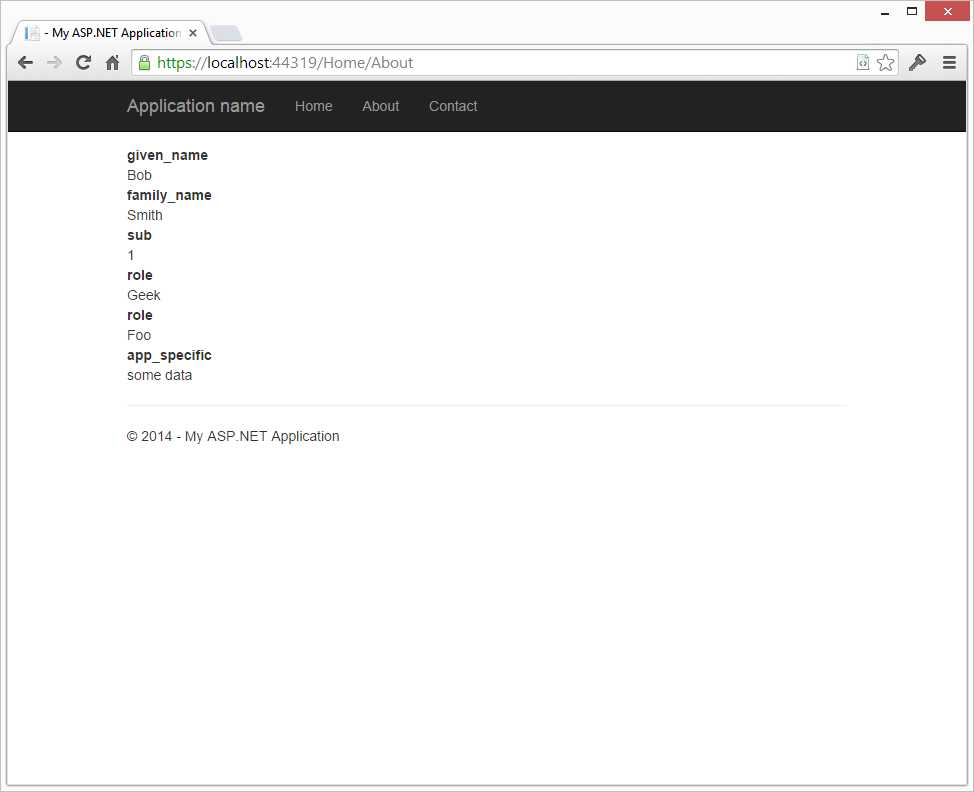
Authorization
现在,我们有身份验证和一些声明,我们可以开始添加简单的授权规则。
MVC有一个内置的属性称为[Authorize]身份验证的用户,您还可以使用此属性来诠释角色成员资格要求。我们不建议这种方法,因为这通常会导致代码,混合的关注,如业务/控制器逻辑和授权政策。我们建议将授权逻辑从控制器中分离,从而导致更清洁的代码和更好的可测性(在 here 阅读更多)。
Resource Authorization
要添加新的授权基础设施和新的属性,我们添加NuGet包:
install-package Thinktecture.IdentityModel.Owin.ResourceAuthorization.Mvc
[ResourceAuthorize("Read", "ContactDetails")] public ActionResult Contact() { ViewBag.Message = "Your contact page."; return View(); }
请注意,属性是不表达权限,我们单独的逻辑去控制权限:
public class AuthorizationManager : ResourceAuthorizationManager { public override Task<bool> CheckAccessAsync(ResourceAuthorizationContext context) { switch (context.Resource.First().Value) { case "ContactDetails": return AuthorizeContactDetails(context); default: return Nok(); } } private Task<bool> AuthorizeContactDetails(ResourceAuthorizationContext context) { switch (context.Action.First().Value) { case "Read": return Eval(context.Principal.HasClaim("role", "Geek")); case "Write": return Eval(context.Principal.HasClaim("role", "Operator")); default: return Nok(); } } }
最后在Startup.cs中添加配置:
app.UseResourceAuthorization(new AuthorizationManager());
运行示例,并通过代码来熟悉验证的流程。
Role Authorization
通过重写AuthorizeAttribute控制返回的结果
// Customized authorization attribute: public class AuthAttribute : AuthorizeAttribute { protected override void HandleUnauthorizedRequest(AuthorizationContext filterContext) { if (filterContext.HttpContext.User.Identity.IsAuthenticated) { // 403 we know who you are, but you haven‘t been granted access filterContext.Result = new HttpStatusCodeResult(System.Net.HttpStatusCode.Forbidden); } else { // 401 who are you? go login and then try again filterContext.Result = new HttpUnauthorizedResult(); } } } // Usage: [Auth(Roles = "Geek")] public ActionResult About() { // ... }
其他的授权和处理访问被拒绝的情况
通过在HomeController中添加一个新的Action来进行更多的授权:
[ResourceAuthorize("Write", "ContactDetails")] public ActionResult UpdateContact() { ViewBag.Message = "Update your contact details!"; return View(); }
当你试图访问这个地址的时候,你会看到一个被禁止的错误页面。
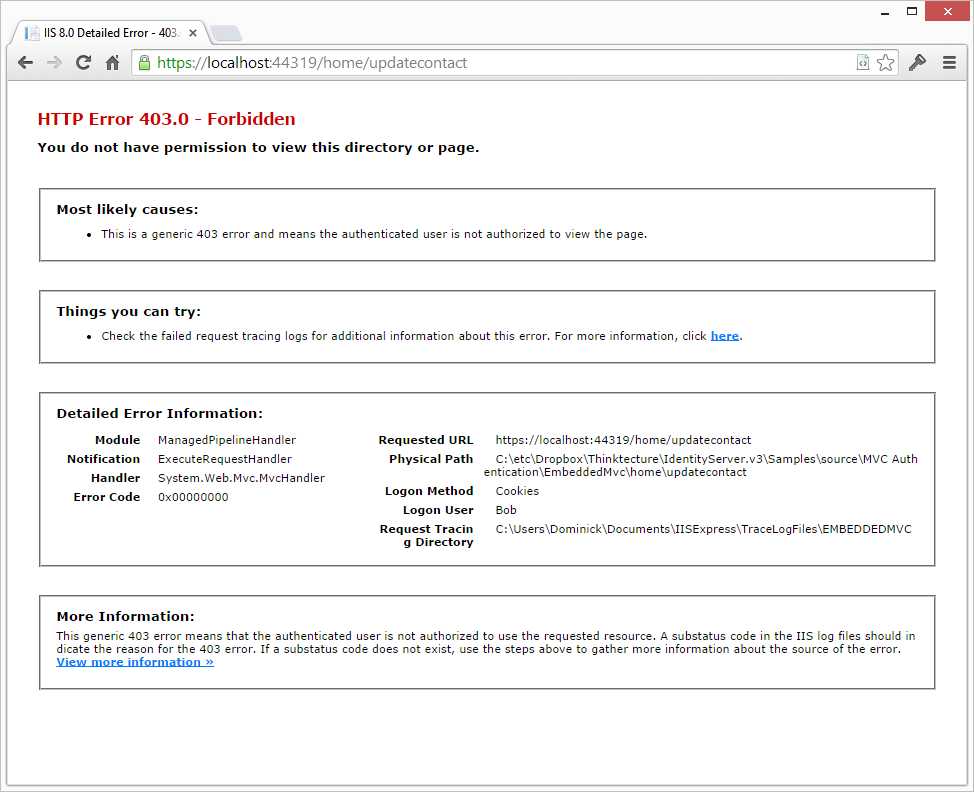
事实上,如果用户已经通过认证,你会看到不同的响应。如果不是MVC将重定向到登录页面,如果通过验证,您会看到禁止响应。这是由设计(阅读更多 here)。
你可以通过检查403个状态码来处理这个被禁止的情况,我们提供了一个这样的过滤框:
[ResourceAuthorize("Write", "ContactDetails")] [HandleForbidden] public ActionResult UpdateContact() { ViewBag.Message = "Update your contact details!"; return View(); }
添加HandleForbidden 后,看起是这样:
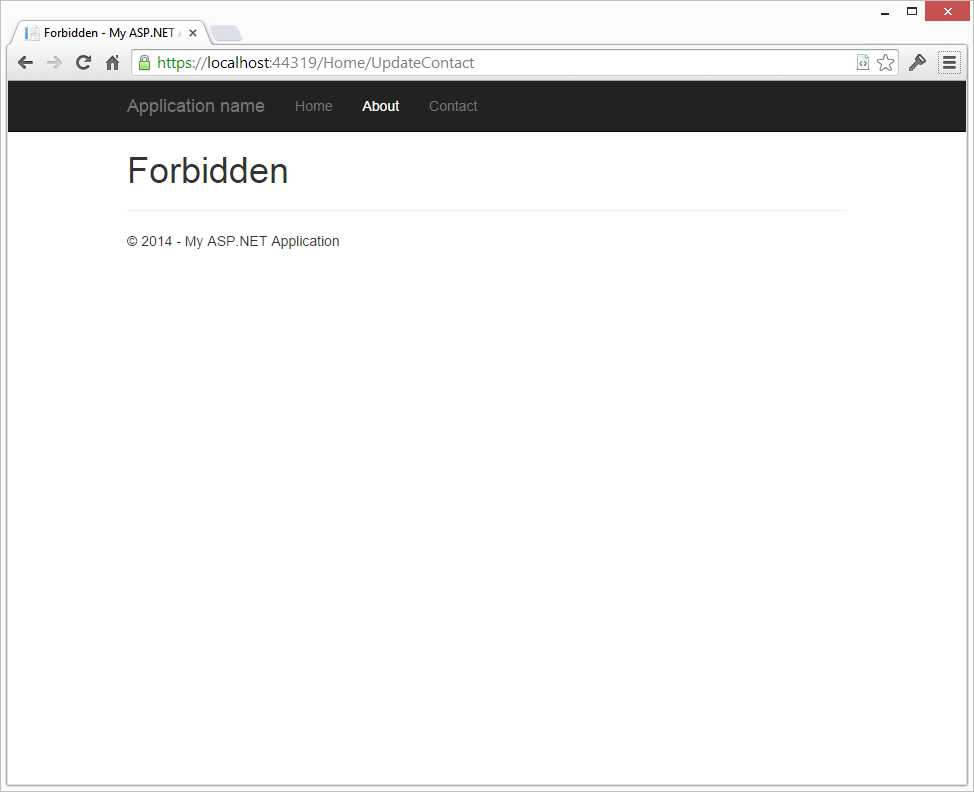
你也可以使用授权管理器势在必行,这给你更多的选择:
[HandleForbidden] public ActionResult UpdateContact() { if (!HttpContext.CheckAccess("Write", "ContactDetails", "some more data")) { // either 401 or 403 based on authentication state return this.AccessDenied(); } ViewBag.Message = "Update your contact details!"; return View(); }